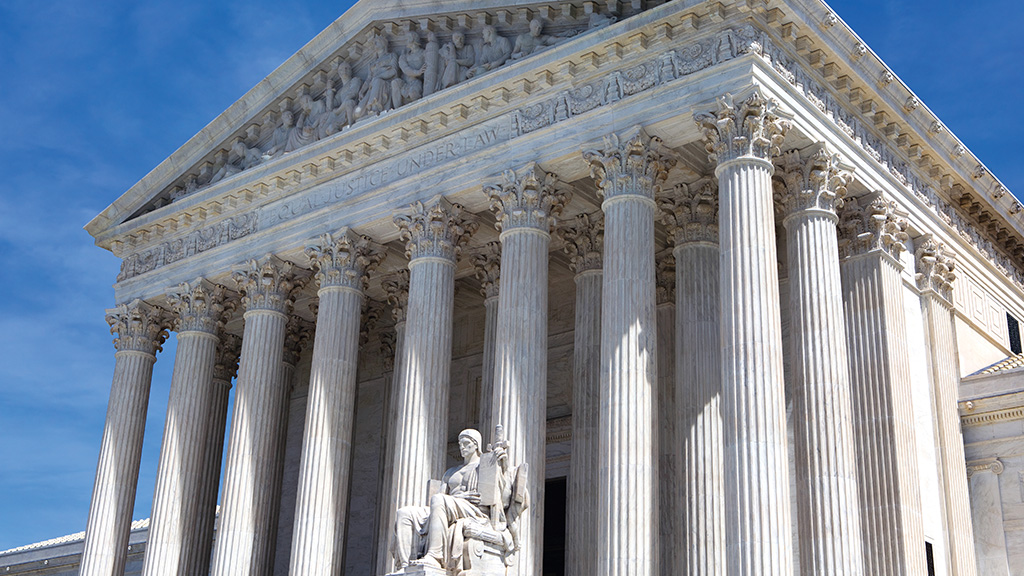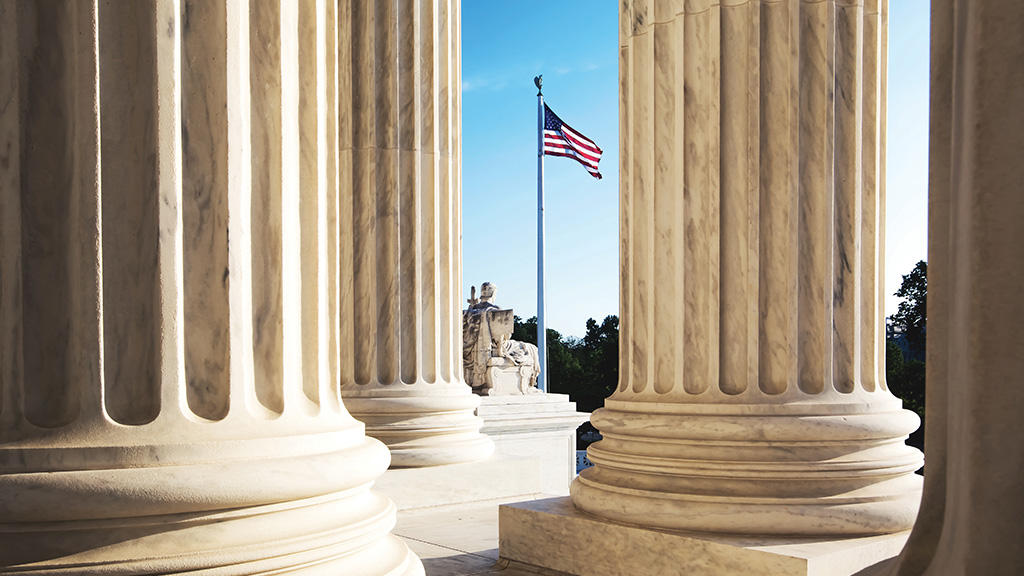
FRAME/STOCK.ADOBE.COM
Nearly seven decades after the landmark decision in Brown v. Board of Education of Topeka, which paved the way for equity in education for Black children, the U.S. Supreme Court has rewritten the rules for higher education admissions in a way that makes the promise of Brown evanescent. That promise was as much about recognizing and reversing the harms suffered by Black children—resulting from a legal framework that denied them quality education and resources afforded to white students—as it was about declaring racial segregation unconstitutional.
Since Brown, the High Court increasingly has been willing to revisit the historical underpinnings for that promise. This willingness has led it to question the constitutionality of even limited measures aimed at correcting the unfairness and consequences wrought by segregation and institutionalized racism in education, particularly in university admissions. For a majority of the Court, the question is now clearly whether so-called racial “preferences” can gel with aspirations of color-blindness, regardless of important societal interests in redressing historical inequities and reaping the educational benefits of diversity. The Court majority apparently seeks to make good on Justice Sandra Day O’Connor’s warning-cum-forecast of the end of such measures, envisioning a time 25 years from now when “the use of racial preferences [would] no longer be necessary.”
This year, just two years shy of Justice O’Connor’s forecast, the Supreme Court deemed that that time has arrived, brushing aside those historical underpinnings of Brown that made reversing past harms a constitutional permissible remedy, and bringing to fruition Chief Justice John Robert’s previous declaration that “[t]he way to stop discrimination on the basis of race is to stop discriminating on the basis of race.”
Students for Fair Admissions (SFFA) sued Harvard and the University of North Carolina (UNC) on behalf of its members, including Asian American students who were denied admission, alleging violations of Title VI and the 1st Amendment. SFFA argued that higher education should not be able to use race as a factor in admissions without proving a race-neutral alternative would cause a dramatic sacrifice in academic quality or the educational benefits of overall student-body diversity. The Supreme Court agreed, ruling that the universities had neither proved that diversity constituted an academic benefit, nor if it had, how the Court could test it.
What is still permissible?
So, what does this decision mean for K-12 students and schools? Does it portend the end for any consideration of race at the elementary and secondary levels? Or, as some have suggested, is the decision narrowly applicable to university admissions with limited applicability to K-12?
The answer, as with so many things legal, depends.
NSBA filed an amicus brief in support of Harvard and UNC’s diversity policies, arguing that diversity is a compelling interest throughout the educational spectrum. NSBA argued that preventing racial isolation and deriving the educational benefits of diversity are legitimate and compelling pedagogical interests, which the Court should not diminish. You can read NSBA’s amicus brief at bit.ly/43YL7lr
It is important to understand that the Supreme Court’s opinion dealt specifically with admission policies at highly selective institutions of higher education. Because issues of student assignment in public elementary and secondary schools are markedly different than university admissions, schools would do well to pause before assuming that this latest decision completely negates the use of race-conscious policies at the K-12 level.
Since the High Court’s 2007 ruling in the Parents Involved in Community Schools v. Seattle School District No. 1 (PICS), the use of race to assign an individual student to a particular school or program has generally been understood to be impermissible. But the principle the PICS decision provided, which was not disturbed by the latest Court ruling, is that race-conscious policies remain viable options for schools interested in reaping the educational benefits of diversity. This means that school districts may “seek to reach Brown’s objective of equal educational opportunity,” and “to consider the racial makeup of schools and to adopt general policies to encourage a diverse student body, one aspect of which is its racial composition,” according to the PICS decision.
School boards may employ a wide range of race-conscious policies as they design and implement student assignment policies aimed at creating diverse learning environments in keeping with Supreme Court precedent. They may, for instance consider numerous individual characteristics—including race, ethnicity [provided it is not the sole determinative criteria], sex, socioeconomic status, family status, geographic location, personal or family preference, etc.—or can draw on other means for assignment, including strategic site selection for new schools, carefully determined school attendance zones, or consideration of neighborhood demographics, according to “Achieving Educational Excellence for All: A Guide to Diversity-Related Policy Strategies for School Districts,” published by NSBA in 2011.
Districts also may consider inter-district transfer policies with nearby districts, develop competitive high school admissions programs, create access to resources such as Advanced Placement (AP) and International Baccalaureate (IB) courses or study plans. They may tailor the allocation of resources to support student learning, including creating faculty and staff recruiting pools that support a district’s efforts to achieve the educational benefits of diversity for students. All these approaches or tools need not be devoid of considerations regarding race or ethnicity provided they are “narrowly tailored” to a school district’s compelling interest in achieving the educational benefits of diversity for students and subject to constitutional parameters.

TIERNEY/STOCK.ADOBE.COM
What legal challenges can we expect?
In the view of the Supreme Court majority, the admissions programs of Harvard and UNC created a zero-sum game in which students for whom race was a plus-factor were given admission, while others not of that race were not. For the Court, a binary in/out determination is impermissible where race is a negative factor for some. This is uniquely true for competitive higher education institutions that have a very limited number of admission slots available compared to the number of applicants. A “yes” for one applicant means a “no” for another.
The most direct application of the Students for Fair Admissions decision to K-12 public education likely will be in the context of competitive admission to magnet and other programs. One federal appellate court recently addressed such a program in Fairfax County, Virginia, where a coalition of parents sued the school district, challenging a new admissions policy at Thomas Jefferson High School, a magnet school. In its attempt to make the school’s student body more diverse, the board stopped requiring standardized tests and guaranteed admission slots for students at certain eligible middle schools. A federal district court agreed with the parents and held that the policy was unconstitutional, but the U.S. Court of Appeals for the Fourth Circuit ruled in favor of the school district and the new admission plan.
Beyond individual-based student admissions policies, however, school districts should be aware that the Students for Fair Admissions decision may be interpreted by some as an invitation to challenge more “general” programs. If a majority of the Supreme Court believes that the Equal Protection Clause requires race neutrality (or “race blindness”) by government, it may be open to challenges of more general programs in the future.
And, the Court appears to have signaled its willingness to hear such challenges. It not only found the educational benefits of diversity to be vague and unproven by the universities, but also questioned whether such factors could be subject to evaluation by the High Court in way that would render them constitutionally acceptable.
Another signal of its openness to further challenges may be the Court’s caution against intentional misreading of its decision by educational institutions. Justice Roberts warned that institutions of higher education “may not simply establish through application essays or other means the regime we hold unlawful today. (A dissenting opinion is generally not the best source of legal advice on how to comply with the majority opinion.) ‘[W]hat cannot be done directly cannot be done indirectly. The Constitution deals with substance, not shadows,’ and the prohibition against racial discrimination is ‘levelled at the thing, not the name.’”
How do we best defend our diversity policies?
In designing diversity policies, school boards first should be clear that the purpose behind their policies is to reap educational benefits for their students. In other words, school boards should understand and be able to articulate in policies themselves how their diversity policies will deliver pedagogical benefits. Reliance on academic studies is one basis for beginning a school board’s inquiry. For instance, studies show that diversity or “[r]acial integration is a rare case where an educational policy appears to improve educational equity at little financial cost.”
But districts must do more than simply cite studies. They should be able to identify the specific benefits that the policy will produce, i.e., increased academic performance; supportive school climate, leadership and civic skill development; improved graduation rates or college and career readiness measured by admissions or subsequent program/job placement; and increased participation in AP and IB programs.
To minimize constitutional liability, school district diversity policies should identify the specific benefits that the policy will produce, such as:
-
Increased academic performance.
-
Supportive school climate, leadership, and civic skill development.
-
Improved graduation rates or college and career readiness measured by admissions or subsequent program/job placement.
-
Increased participation in AP and IB programs.
School districts should have processes in place for regular review and evaluation of diversity policies over time, including what race neutral alternatives were considered and why they were deemed insufficient to achieve the educational goals. (Piloting race-neutral alternatives that demonstrate that particular approach’s insufficiency can be one way of supporting a district’s ultimate choice). This means that districts should be prepared to demonstrate how a particular diversity policy has resulted in measurable outcomes. Where such outcomes have not been attained, the school district should be able to show how it has shifted or discarded policies that did not achieve intended outcomes.
Evolving legal landscape
Despite the Supreme Court’s latest decision, the rules for diversity policies in K-12 so far remain unchanged from the Court’s 2007 PICS decision. But the legal landscape continues to evolve, and the Court’s majority is clear that the more individualized use of race previously supported by the Court is at an end, at least regarding university admissions.
The decision, however, presents an opportunity for school boards to revisit their diversity aims and to reevaluate their existing policies to ensure compliance with constitutional requirements. If the Court has signaled anything to K-12, it is that the strict scrutiny of even race-conscious measures demands that school districts understand not only the academic objectives behind their diversity policies, but also how their policy is narrowly tailored to achieve those objectives. Because the legal framework is complex and evolving, school districts reviewing and developing diversity policies should confer with their school attorney member of the Council of School Attorneys to ensure compliance with existing constitutional requirements, and for assistance in developing a policy that minimizes legal risk.
At a time when our students are more diverse than ever before, school districts will undoubtedly face questions from families, communities, and students about how their policies will best serve them. Diversity policies can be a powerful tool in delivering educational benefits for kids. However, doing it in a constitutional manner is a growing challenge.
Francisco M. Negrón Jr. (fnegron@nsba.org) is NSBA’s Chief Legal Officer.


Share this content